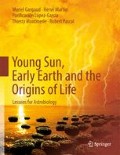Abstract
Suns, Earths ... Life?
In the universe, there is one particular galaxy, among billions of others ... In that galaxy, there is one Sun, among 200 billion others ... And around that Sun, a small, blue, “Goldilocks” planet, which is neither too hot, nor too cold, that today shelters an incalculable number of living beings. This living planet, the Earth, seems unique in the universe because it is ours.
What about the other places in our Solar System, such as planets and their satellites? Do they show any sign of life? And, farther away, what about planetary systems around other stars? Do they exist, and if so, do they harbor planets that could be living worlds, at least based on what we have learned about the Earth in the preceding chapters of this book, in other words “life as we know it”? Astronomers, geologists, planetologists, and biologists, interested in the search for extraterrestrial life, have made tremendous progress over the last decade or so, giving many answers to these questions, but at the same time, raising other equally tantalizing interrogations and yet unsolved problems. In the present chapter we attempt to summarize this very rapidly expanding, multidisciplinary field of science, from the point of view of an astronomer.
Access this chapter
Tax calculation will be finalised at checkout
Purchases are for personal use only
Notes
- 1.
. The Cassini-Huygens interplanetary mission is a joint ESA/NASA/ASI (Italian Space Agency) project. It was launched on 15 Oct. 1997. It consists in the Cassini spacecraft, put into orbit around Saturn on July 1st, 2004, and the Huygens descent vehicle, which landed on Titan on 14 Jan. 2005.
- 2.
. Movie fans may recall that Europa is also the enigmatic, sub-ice life-bearing target of the “Discovery” expedition in the film “2010,” a sequel to Stanley Kubrik’s “2001, A Space Odyssey,” released in 1984.
- 3.
. Just two other pulsars are known to have planets, and they are very different systems, each with a single planet, with periods of 2.18 hours and 10 years, respectively.
- 4.
. The designations of exoplanets are far from being homogeneous. The Geneva school of thought (led by Michel Mayor and his colleagues) designates them by the name of the parent star, followed by lower-case letters of the alphabet, in increasing order of their distance from the star. So the name of the planet in orbit around the star 51 Peg is 51 Peg b.
- 5.
. For detailed observational data on exoplanets, see the online Encyclopaedia of extrasolar planets: http://exoplanet.eu/ .
- 6.
. The limit for the fusion of deuterium is 13 Jupiter masses. Beyond this the object is considered to be a star, because it generates its own energy. (It is a “brown dwarf,” up to the hydrogen fusion threshold at 0.08 solar masses or 80 Jupiter masses).
- 7.
. A very recent announcement (December 2011) revealed that Kepler had discovered two planets of the size of the Earth, as well as three the size of Mars, but very close to their parent stars. These are not, therefore, “Earths” comparable with ours.
- 8.
. This pressure regime does not apply to all living organisms. On Earth, certain “extremophile” bacteria can survive at great depth and at temperatures above 100 °C, or both (◘ Table 4.4, Chap. 4). Expressed simply, however, the regime mentioned applies to the vast majority of organisms that we know about.
- 9.
. However, a ten-fold improvement will soon be obtained by the use of the interferometric method on the VLT (VLTI), and one hundred times better with the European GAIA astrometric satellite, which will be launched in 2013.
- 10.
. In fact the first exoplanets were discovered in 1992, but these were planets orbiting pulsars (neutron stars that are rotating extremely rapidly), and were found by measurements of variations in the pulsations ( text). Because this is a very specialized environment, the term “exoplanet” will be used here exclusively for a planet orbiting a normal star.
- 11.
. Reference to the Encyclopaedia of Extrasolar Planets (http://exoplanet.eu/) will be found to be of great benefit.
- 12.
. The three principal characteristics of a planetary orbit are: (i) the distance of the planet from the star (more precisely, the extent of the semi-major axis of the orbit); (ii) its eccentricity; (ii) its inclination relative to the star’s equator. To simplify things here, and without going into particular cases, we shall assume that the planets describe circular orbits in the stars’ equatorial planes. But apart from the inclination, which is more difficult to determine, these values may equally be measured in most cases.
- 13.
. The observations were conducted by A. Eddington, who took measurements during an expedition to the small island of Sao-Tomé-and-Principe, off the coast of Gabon, in equatorial Africa. The eclipse was also observed at Sobral, on the Brazilian coast.
Author information
Authors and Affiliations
Corresponding authors
Rights and permissions
Copyright information
© 2012 Springer-Verlag Berlin Heidelberg
About this chapter
Cite this chapter
Gargaud, M., Martin, H., López-García, P., Montmerle, T., Pascal, R. (2012). Other Planets, Other Living Worlds?. In: Young Sun, Early Earth and the Origins of Life. Springer, Berlin, Heidelberg. https://doi.org/10.1007/978-3-642-22552-9_8
Download citation
DOI: https://doi.org/10.1007/978-3-642-22552-9_8
Published:
Publisher Name: Springer, Berlin, Heidelberg
Print ISBN: 978-3-642-22551-2
Online ISBN: 978-3-642-22552-9
eBook Packages: Physics and AstronomyPhysics and Astronomy (R0)

